William H. Campbell, an orphaned Los Angeles native, met Elizabeth Warder Crozer, daughter of a wealthy Philadelphia banker and manufacturer, at the wedding of a mutual friend, in Pasadena, where they were both members of the bridal party.
It was love at first sight.
Shortly after meeting, in the spring of 1917, Bill enlisted and after a year's training, he went overseas to join the Allied Forces for the duration of the First World War. For Elizabeth, this time of waiting for his safe return dragged on endlessly.
Although their hearts were singing with love, troubled times were ahead; in November of that year, just two days before armistice, Bill had been exposed to mustard gas, and so he returned to Elizabeth frail, and in decline.
Despite his frail condition, and despite her parent's objections, the couple married on May 27, 1920. The rapidity of their courtship shocked Elizabeth's father and mother, who disapproved of war marriages. Their marriage resulted in a family rift, leaving the couple cut off financially.
It was love at first sight.
Shortly after meeting, in the spring of 1917, Bill enlisted and after a year's training, he went overseas to join the Allied Forces for the duration of the First World War. For Elizabeth, this time of waiting for his safe return dragged on endlessly.
Although their hearts were singing with love, troubled times were ahead; in November of that year, just two days before armistice, Bill had been exposed to mustard gas, and so he returned to Elizabeth frail, and in decline.
Despite his frail condition, and despite her parent's objections, the couple married on May 27, 1920. The rapidity of their courtship shocked Elizabeth's father and mother, who disapproved of war marriages. Their marriage resulted in a family rift, leaving the couple cut off financially.
A move west
In February 1921, on account of Bill's declining health, the couple moved to Pasadena, California, in the hopes a drier climate would benefit Bill's burned lungs.
In Pasadena they sought the services of a doctor who was purported to have helped other returning veterans suffering from the same effects of exposure to mustard gas. His name was Dr. James B. Luckie, known today as the "father of Twentynine Palms." Dr. Luckie is estimated to have sent more than 300 ailing veterans to benefit from what he saw as the restorative effects of a high altitude, warm and dry environment with clean air and water.
After a year in Pasadena, with Bill's health continuing to decline, Elizabeth recalls being told bluntly by the doctor that his "chances of recovery were slim, and I had better take him to the desert if I hoped to save him." With Bill unable to work, and their mounting medical expenses, the couple took Dr. Luckie's advice and entered what they considered an exile.
Exile to the desert
With nothing more than light camping equipment, including two folding chairs and a card table, the couple got into their second-hand Franklin car, and started out for the desert. It was December, 1924.
"The day before we had driven in a howling, choking sandstorm that was bad for Bill's lungs. The clouds of dust were so thick that at times we had to get out and hunt for the pavement to be sure we were still on the road.
Finally, on an old man's recommendation we followed a dim wagon track, which, twisting through mountains and valleys, brought us to a line of springs in a desert valley, where we found shelter from the wind."
A desert Oasis
The line of springs where they camped was the Oasis of Mara, a place where life had flourished for thousands of years, and once home to both the Serrano and Chemehuevi Indians. Although there were only eight or nine small houses and shacks in the area at the time, Elizabeth recalls there was a steady flow of people who came to the Oasis for water.
"Cow men passing through, miners going and coming from distant claims, prospectors with their burros, and occasionally a stray tourist. Once a long caravan of Indians passed, going east. Most of them were in the saddle. At the springs they halted, looked about, stolidly gazed at the trees, and moved on. Knowing how Indians had been dispossessed of the oasis by the usual unfair methods, I wondered what was in their minds as they sat looking at us."
Homesteading & the Pioneer Spirit
In February 1925, at the end of what must have been a joyful, albeit exhausting, search the Campbell's selected a location that "seemed to have every virtue," and so with a claim on file the Campbell's embarked on a years-long labor of love.
Water was the first and greatest need for the Campbell's, who discovered quickly the back-breaking work hauling water over from the springs at the Oasis was. "Nothing connected with homesteading is ever quite so dramatic as when you strike water in your well," and dramatic it was for the Campbell's who had to dig 74 feet before they struck water. In her book, Elizabeth would recall that she "never got over the miracle of dipping up water like that in my desert surroundings."
The next decision was a hard one for the Campbell's to make - put up a windmill, or build a cabin? They needed shelter from the elements, and decided first to build a cabin.
In February 1925, at the end of what must have been a joyful, albeit exhausting, search the Campbell's selected a location that "seemed to have every virtue," and so with a claim on file the Campbell's embarked on a years-long labor of love.
Water was the first and greatest need for the Campbell's, who discovered quickly the back-breaking work hauling water over from the springs at the Oasis was. "Nothing connected with homesteading is ever quite so dramatic as when you strike water in your well," and dramatic it was for the Campbell's who had to dig 74 feet before they struck water. In her book, Elizabeth would recall that she "never got over the miracle of dipping up water like that in my desert surroundings."
The next decision was a hard one for the Campbell's to make - put up a windmill, or build a cabin? They needed shelter from the elements, and decided first to build a cabin.
House Rising
By late 1925 Bill and Elizabeth begun building the foundation of a stone house addition, to adjoin their wood cabin on the south side. It was at this time that Elizabeth received news that her father, on his deathbed, had added her back into his will. The inheritance came in the form of a trust that provided Elizabeth with a liberal income for the rest of her life. The Campbell's continued much of the work themselves, but local oral history recounts that they offered to pay 25 cents for any stone suitable for the house construction which was delivered to the site. The trust would allow them to incorporate many elements into the homestead that otherwise would have been beyond their means.
Stone elements such as the main house foundation, fireplaces, soaring exterior walls, and also the reservoir, took a lot of extra time because each rock was selected one at a time, often from sites great distances away.
Bill placed a solid white glistening quartz stone on the south wall, proclaiming "this is my craving for self-expression!"
The magnificent stone house rose bit by bit, revealing an 11-room mansion, modeled after Elizabeth's own childhood home...It would take nearly three years work to complete, which was finally done in 1929.
"We were young, devoted and eager. So much beckoned ahead.
Our hearts were singing with love, youth, and the promise of a happy future."
Our hearts were singing with love, youth, and the promise of a happy future."
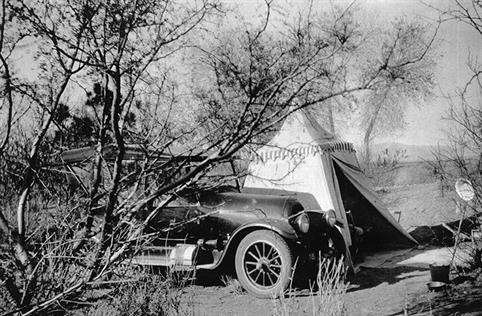
Love at first sight
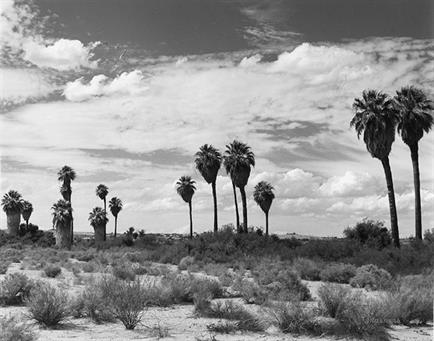
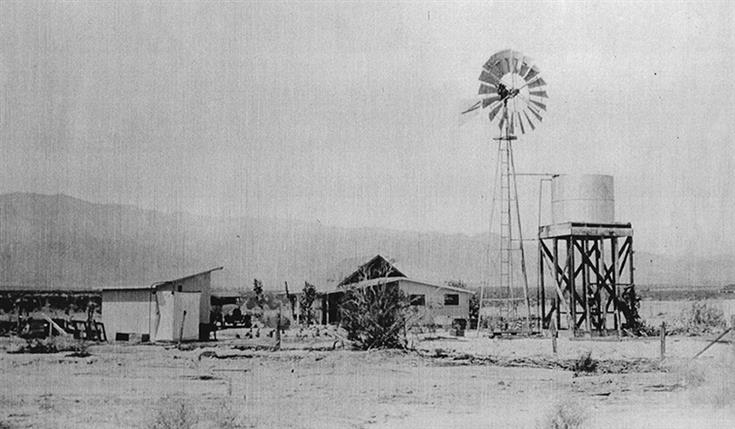
Onward & Upward
From building the cabin, to putting up the windmill, to getting running water into their cabin, life on their homestead was coming together for Campbell's. Next came a garden, which Elizabeth started with clippings and seeds from friends' gardens. She planted cottonwoods, willows and athel trees, and Bill having cornered off a two-acre space had success with watermelons, cantaloupe and squash.
From building the cabin, to putting up the windmill, to getting running water into their cabin, life on their homestead was coming together for Campbell's. Next came a garden, which Elizabeth started with clippings and seeds from friends' gardens. She planted cottonwoods, willows and athel trees, and Bill having cornered off a two-acre space had success with watermelons, cantaloupe and squash.
They planned a "floor space 14 x 18 feet, and laid a cement floor, using gravel and sand from our place, madly rushing back and forth with buckets of water." The Campbell's moved into their "house" before they had any roofing, doors, windows or lining, all of which came later, and just in time.
"Our first rain came three days after the last shingle was nailed on the roof. We listened to the patter above our dry heads, grinned at each other, and felt like millionaires."
This humble one-room cabin had the basics. "One corner of our cabin held a bed, one a kitchen cabinet made of boxes, one our card table with a kerosense lamp, and the camp chairs stood about. Bill built a wooden table to go across one end of the room."
"Our first rain came three days after the last shingle was nailed on the roof. We listened to the patter above our dry heads, grinned at each other, and felt like millionaires."
This humble one-room cabin had the basics. "One corner of our cabin held a bed, one a kitchen cabinet made of boxes, one our card table with a kerosense lamp, and the camp chairs stood about. Bill built a wooden table to go across one end of the room."
With the cold nights coming, Elizabeth dreamed of a fireplace, and it was then she and Bill started gathering rocks, and found that being rock curious was lots of fun.
"Wait, I would cry as we drove across the desert, Stop, Stop, there's a rock! Out we climbed, discussed its angles and cracks, reared it on end, decided whether it was suitable for a chimney corner, or hearth, and lugging it over to the car, finally heaved it onto the floor boards. By bringing home just a few rocks at a time we finally had enough for a chimney."
"Wait, I would cry as we drove across the desert, Stop, Stop, there's a rock! Out we climbed, discussed its angles and cracks, reared it on end, decided whether it was suitable for a chimney corner, or hearth, and lugging it over to the car, finally heaved it onto the floor boards. By bringing home just a few rocks at a time we finally had enough for a chimney."
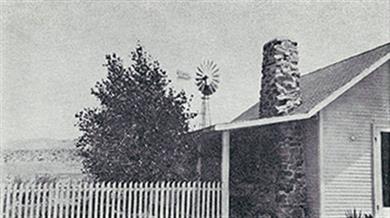
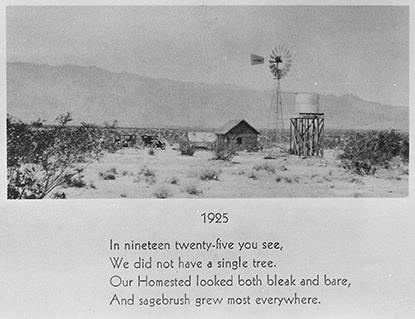
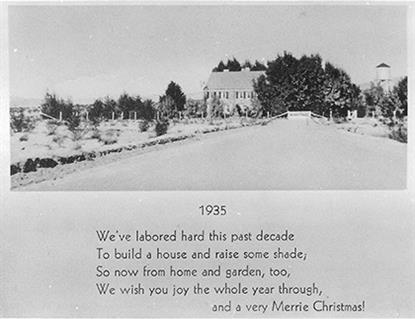
Campbell's Christmas card from 1935

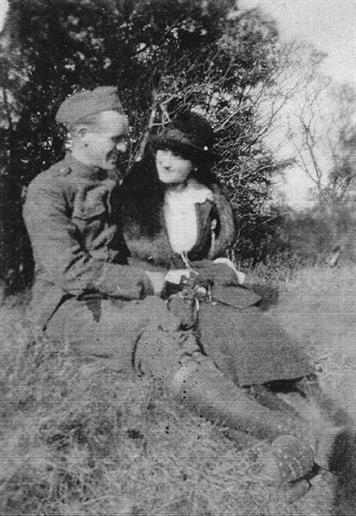


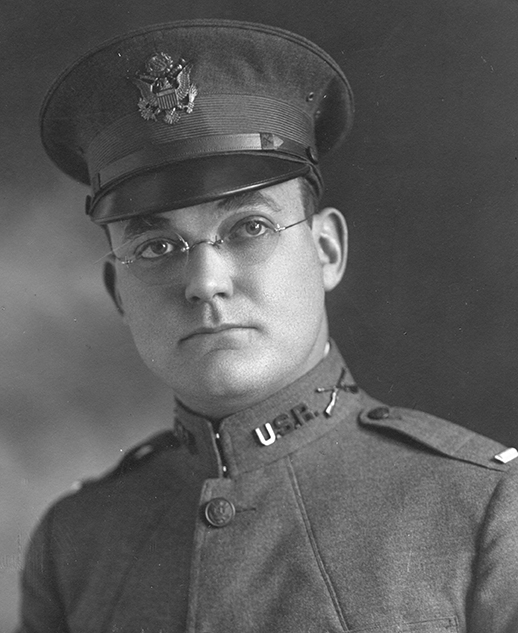
"I was reared in Philadelphia, in a sheltered, conservative home and when I married I couldn't boil water without scorching it. I had never handled a gun in my life, and had never slept outdoors. Bill must have had nerve to take me to the desert, though strangely enough I am not timid nor lacking in courage."
Dr. James B. Luckie, known
today as the "father of
Twenytnine Palms."
today as the "father of
Twenytnine Palms."
What must have been the private thoughts of 31-year-old Elizabeth Campbell as she struggled to sleep on this first night, her husband Bill, beside her? In January the mercury would dip to freezing outside the couple's automobile where they slept each night. Stretched out next to Bill, his regular breathing her signal he was asleep, Elizabeth assessed their situation...Bill knew the outdoors, but he was frail and weak. Their funds on hand barely covered provisions so camping at the car was their only option.
For nearly three months Bill and Elizabeth camped at the Oasis, in the company of cattle and wild burros, prospectors, bootleggers, and the occasional cattlemen, seeing what the air would do for Bill.
As Bill's health was noticeably improving, Elizabeth knew they should stay in the desert, and felt a growing need for a place they could call their own. The Campbell's decision to homestead was also made possible with the news that Bill's armed services pension had been approved. The $95/month was sufficient to live on with enough left over each month to buy building materials.
"We'll build a little cabin, or garage and live in it. We won't stay here long, maybe six months of a year, but we'll always have it for a retreat or vacations."
Little did they know at the time they would end up staying for twenty years.
As Bill's health was noticeably improving, Elizabeth knew they should stay in the desert, and felt a growing need for a place they could call their own. The Campbell's decision to homestead was also made possible with the news that Bill's armed services pension had been approved. The $95/month was sufficient to live on with enough left over each month to buy building materials.
"We'll build a little cabin, or garage and live in it. We won't stay here long, maybe six months of a year, but we'll always have it for a retreat or vacations."
Little did they know at the time they would end up staying for twenty years.
In the daylight, Elizabeth could see that beyond the small oasis and their encampment they were near the southeastern edge of an enormous geologic trough. Surrounded by granite mountains, enormous alluvial discharges fanned out and down toward the sandy basin floor. On meeting the mountains at the east end of the basin the winds would bank up, depositing the sand on the dunes huddled along the mountain bases.
How alien must this worldly young sophisticate have felt set down under the palms at the oasis; the vast Mojave Desert stretched out in every direction. A world away from the polite society of Philadelphia's "main line."
How alien must this worldly young sophisticate have felt set down under the palms at the oasis; the vast Mojave Desert stretched out in every direction. A world away from the polite society of Philadelphia's "main line."
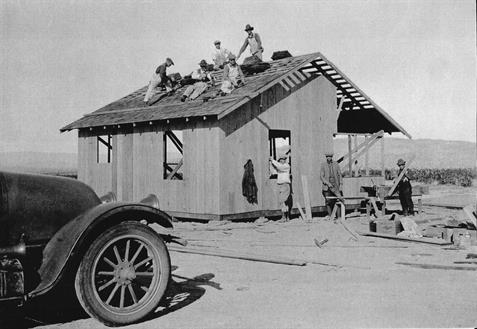
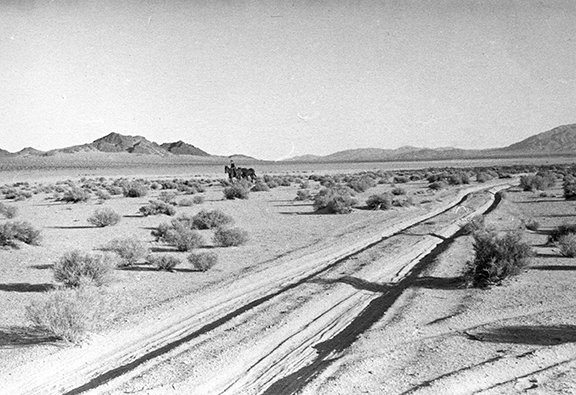
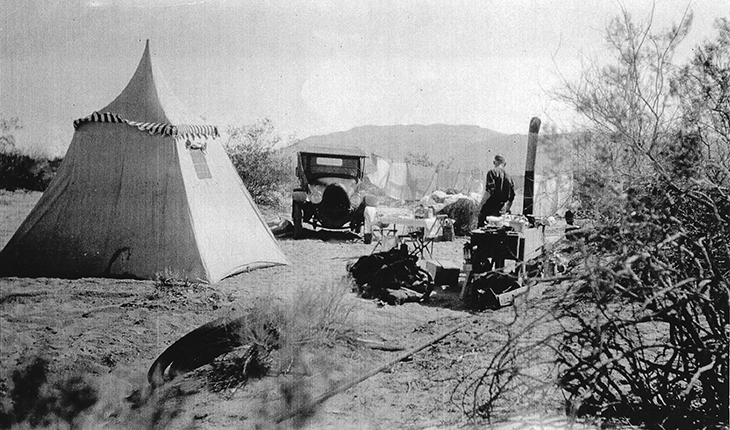
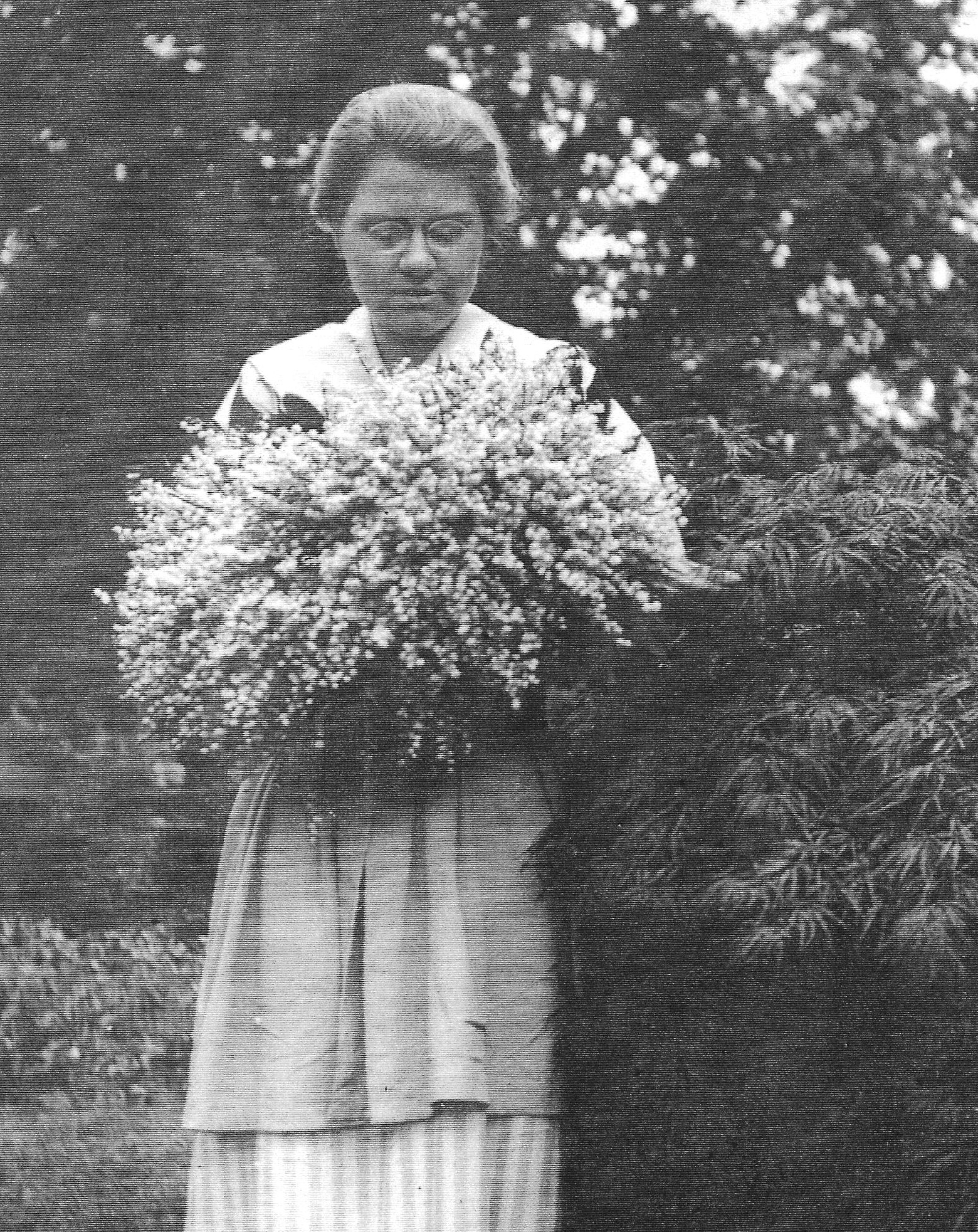
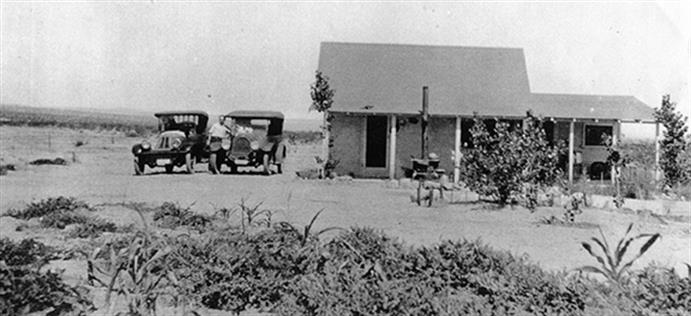
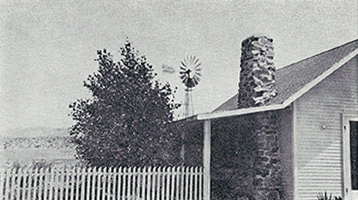
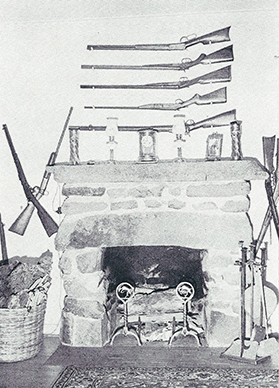

H I S T O R Y W I T H A H E A R T

Formerly the Roughley Manor, the Campbell House returns to its original name to honor and celebrate Bill & Elizabeth Campbell. The history of the storied Campbell House is much more than the age and origin of its bricks and mortar; this is a history with heart.
H I S T O R Y W I T H A H E A R T
H I S T O R Y W I T H A H E A R T
Formerly the Roughley Manor, the Campbell House returns to its original name to honor and celebrate Bill & Elizabeth Campbell. The history of the storied Campbell House is much more than the age and origin of its bricks and mortar; this is a history with heart.

